
Casper Murray
About The Author
Since 2000-s Caper has been teaching History of America in local colleges in Michigan. He is an expert in the US economy and knows all the details that influence the citizens’ wellbeing, and the coinage production is not an exception. As a hobby, he created his own collection of numismatic items.
Casper runs the lectures and organizes the shows for like-minded people. He shares the keys on how to identify the money piece value and where to sell it. But for people with no chance to attend such meetings, Casper posts all the tips for numismatists in social media.
Connect with Casper



Uncovering the Value of Buffalo Nickels
The Buffalo Indian Head nickel value refers to the price of this popular American token. These pieces, often just called “Buffalo Nickels,” are cherished by collectors for their distinctive design featuring a Native American on one side and a Buffalo on the other. First minted in 1913, they hold a unique place in U.S. coinage history, representing a period of significant artistic change.
Key Factors Affecting Value
- Date & Mint Mark: Certain dates and mint marks are rarer and therefore more valuable. The 1913-S, 1926-S, and 1937-D are known as the rarest Buffalo nickels. The Indian Head Buffalo nickel no date value is generally lower, but some can still be worth a few dollars. You can find the mint mark on the reverse side below the Buffalo’s feet.
- Condition: Uncirculated coins, which show no signs of wear, are worth much more than worn ones. In fact, an uncirculated one can be 10 to 100 times more valuable than a circulated one of the same date and mint mark.
- “Full Horn” Detail: If the horn is worn down and not clearly visible, the coin’s value will decrease. Collectors prefer those where the “full horn” detail is sharp and complete.
- Strike Quality: Many Buffalo nickels, especially those from the Denver (D) and San Francisco (S) mints, have weak strikes. This means some of the design details might not be fully formed. Money with strong, clear strikes are more desirable.
Buffalo Nickel Value Chart (2024 Prices)
Our Indian Head nickel value chart can help you understand how much different coins are worth
| Name | Approximate Price |
| 1913-S Type 2 | $575 – $1,200 |
| 1916 Doubled Die Obverse | $66,000 – $281,000 |
| 1918/7-D Overdate | $37,000 – $350,000 |
| 1921-S | $1,150 – $2,340 |
| 1924-S | $2,500 – $4,000 |
| 1926-S | $3,600 – $10,000 |
| 1931-S | $70 – $130 |
| 1935 Doubled Die Reverse | $5,700 – $6,900 |
| 1937-D 3-Legged | $99,875 – $125,000 |
The 1936 Indian Head nickel value is approximate and may vary depending on the condition, market demand, and other factors.
1913-S Type 2 5C
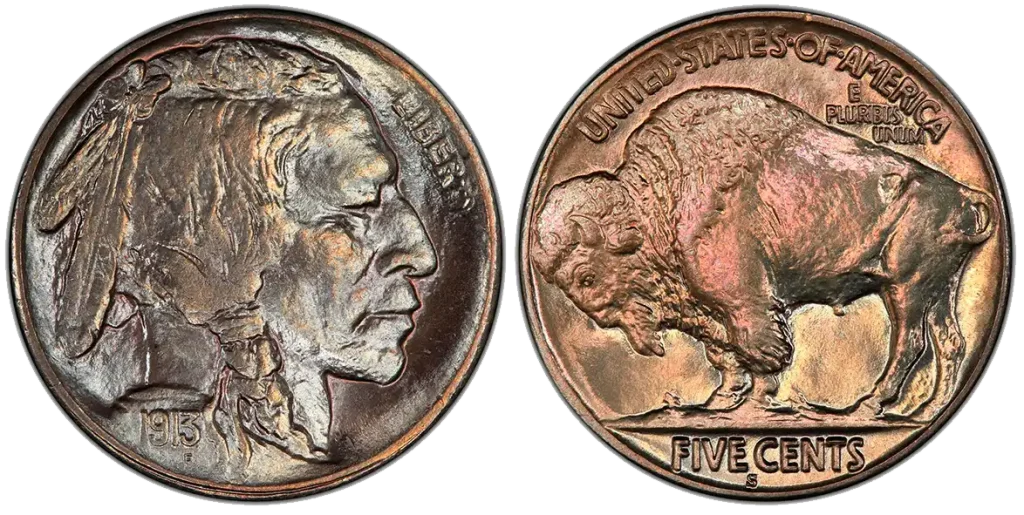
This coin is from the first year of the Buffalo nickel series. Its reverse design was updated to recess the “FIVE CENTS” denomination, aiming to reduce wear. The San Francisco mint mark (S) makes it rare in high grades.
- Mintage: 1,209,000
- Composition: 75% Copper, 25% Nickel
- Weight: 5.00 grams
- Diameter: 21.2 mm
1916 5C Doubled Die Obverse
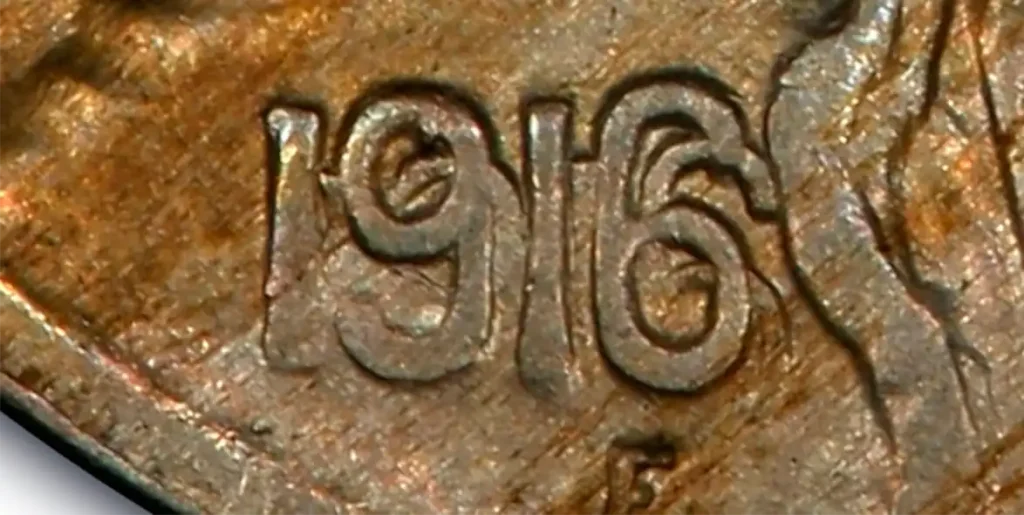
This is a rare error with clear doubling on the date and other features on the front side. This occurred when the coin die was struck twice, with a slight misalignment.
- Mintage: Unknown
- Composition: 75% Copper, 25% Nickel
- Weight: 5.00 grams
- Diameter: 21.2 mm
1918/7-D 5C Overdate
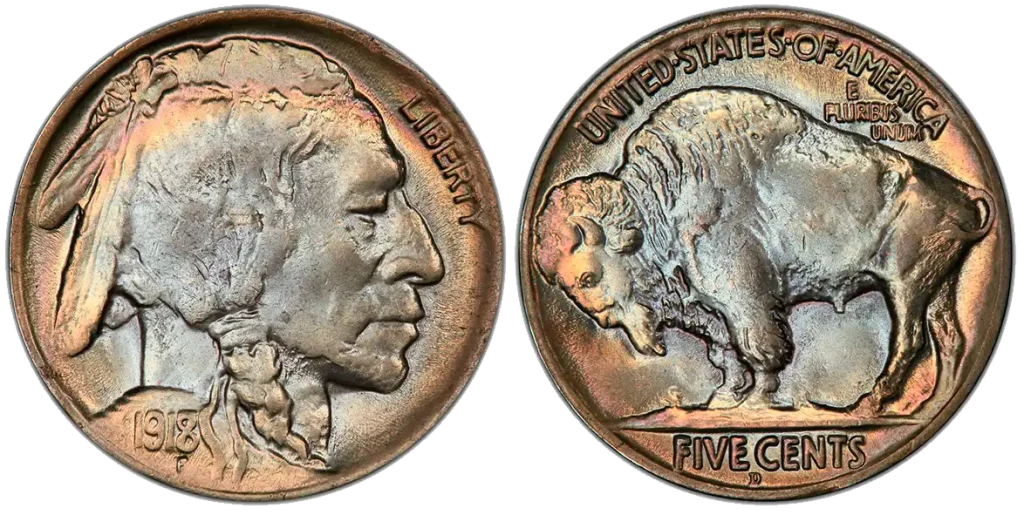
This well-known error shows the digit “7” beneath the “8” in the “1918” date. This overdate happened at the Denver Mint and is highly valued by collectors.
- Mintage: Unknown
- Composition: 75% Copper, 25% Nickel
- Weight: 5.00 grams
- Diameter: 21.2 mm
1921-S 5C
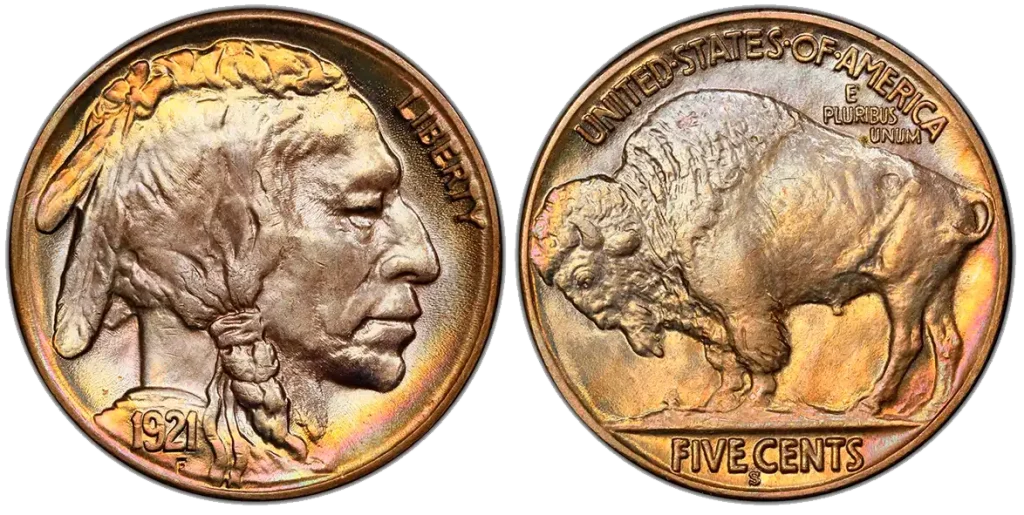
This coin from the San Francisco Mint has a relatively low mintage. It is often found with weak strikes, which makes well-preserved examples quite rare. This one and the 1920 Indian Head nickel value depends on its specific mint mark and overall look.
- Mintage: 1,557,000
- Composition: 75% Copper, 25% Nickel
- Weight: 5.00 grams
- Diameter: 21.2 mm
1924-S 5C
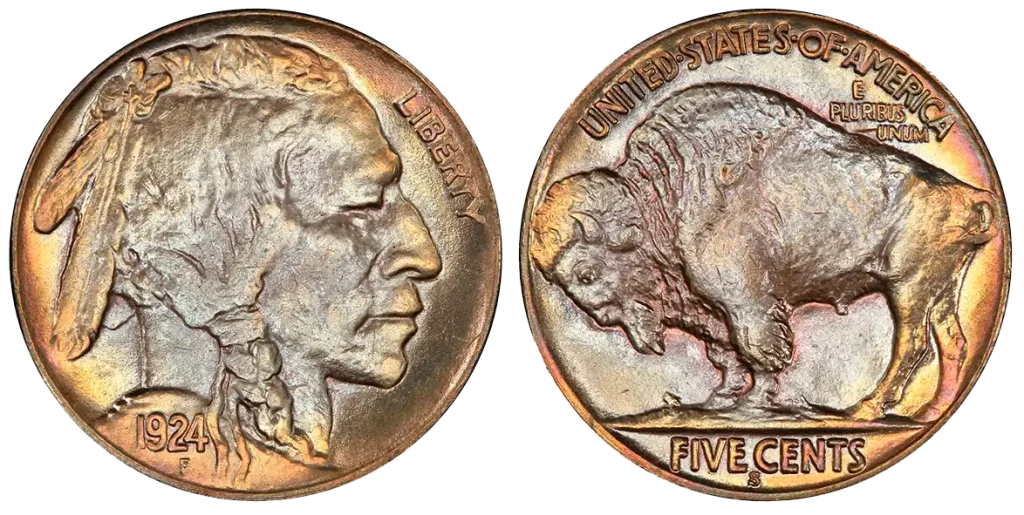
This San Francisco issue is notable for its low mintage and often poor strike quality. Finding this coin with clear details in uncirculated condition is difficult, which increases its value. Additionally, a 1928 Indian Head nickel value can be also expensive for good condition.
- Mintage: 1,437,000
- Composition: 75% Copper, 25% Nickel
- Weight: 5.00 grams
- Diameter: 21.2 mm
1926-S 5C
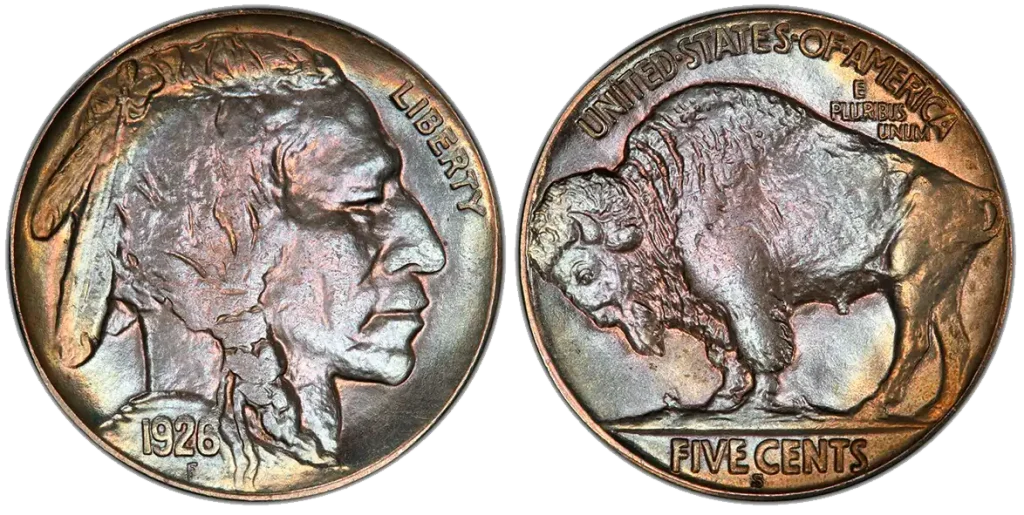
This coin has the lowest mintage of any regular-issue Buffalo nickel, making it a key date for collectors. It is very difficult to find in uncirculated condition, and high-quality examples are very expensive.
- Mintage: 970,000
- Composition: 75% Copper, 25% Nickel
- Weight: 5.00 grams
- Diameter: 21.2 mm
1931-S 5C
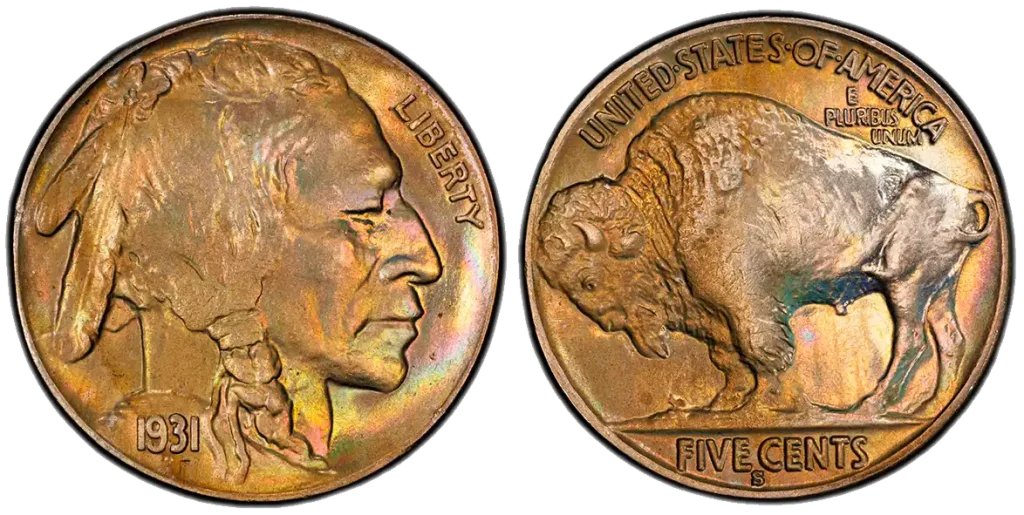
This coin from the San Francisco Mint is considered a semi-key date. Despite its mintage, it can be challenging to find in higher grades due to how it circulated.
- Mintage: 1,200,000
- Composition: 75% Copper, 25% Nickel
- Weight: 5.00 grams
- Diameter: 21.2 mm
1935 5C Doubled Die Reverse
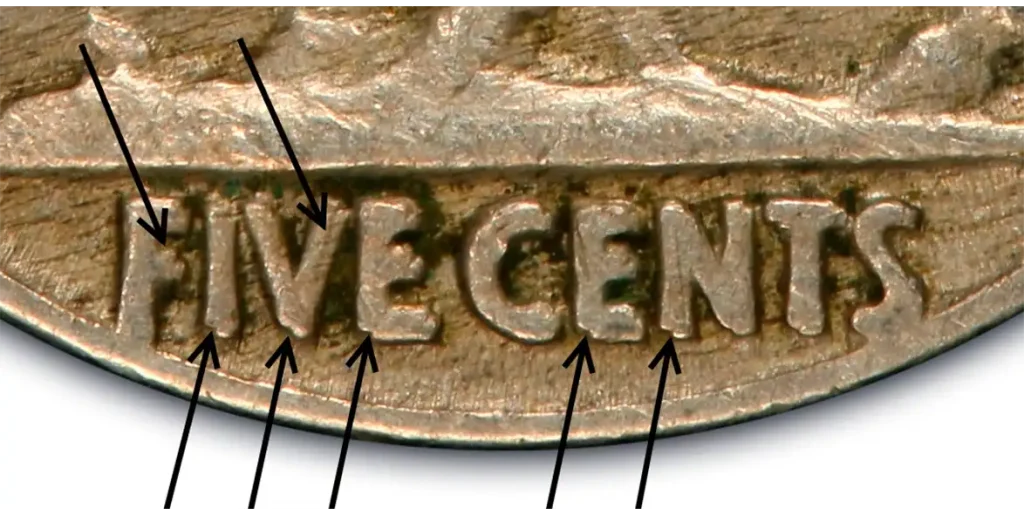
The 1935 Indian Head nickel value can vary depending on how much wear the coin shows. This error coin shows clear doubling on the words and the Buffalo on the back side.
- Mintage: Unknown
- Composition: 75% Copper, 25% Nickel
- Weight: 5.00 grams
- Diameter: 21.2 mm
1937-D 5C 3-Legged
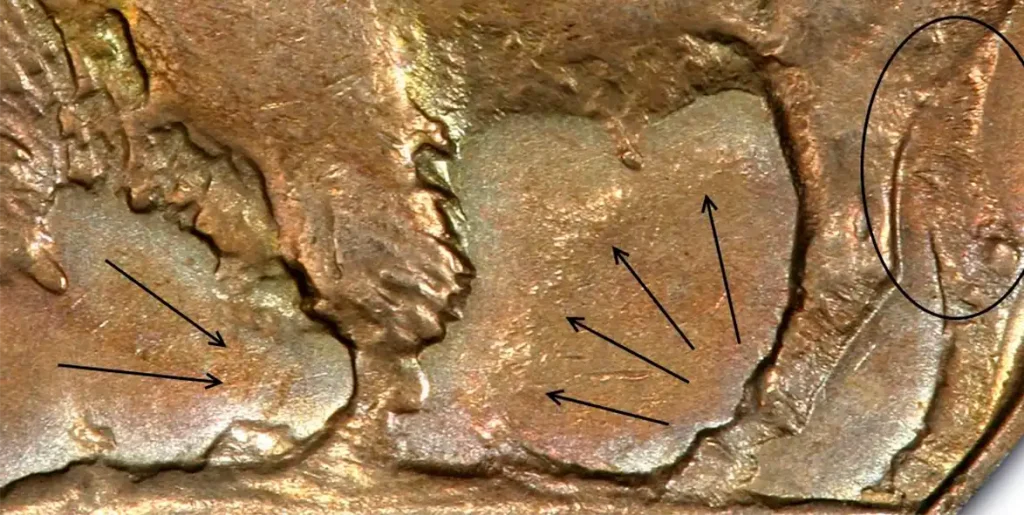
This is one of the most famous U.S. coin errors. A mint worker at the Denver Mint accidentally removed the Buffalo’s front right leg while polishing a die. This error makes it exceptionally valuable. The 1937 Indian Head Buffalo nickel value is famous due to its rare error versions.
- Mintage: Unknown
- Composition: 75% Copper, 25% Nickel
- Weight: 5.00 grams
- Diameter: 21.2 mm
Most Valuable Buffalo Nickels
1913-S Type 2 Buffalo Nickel
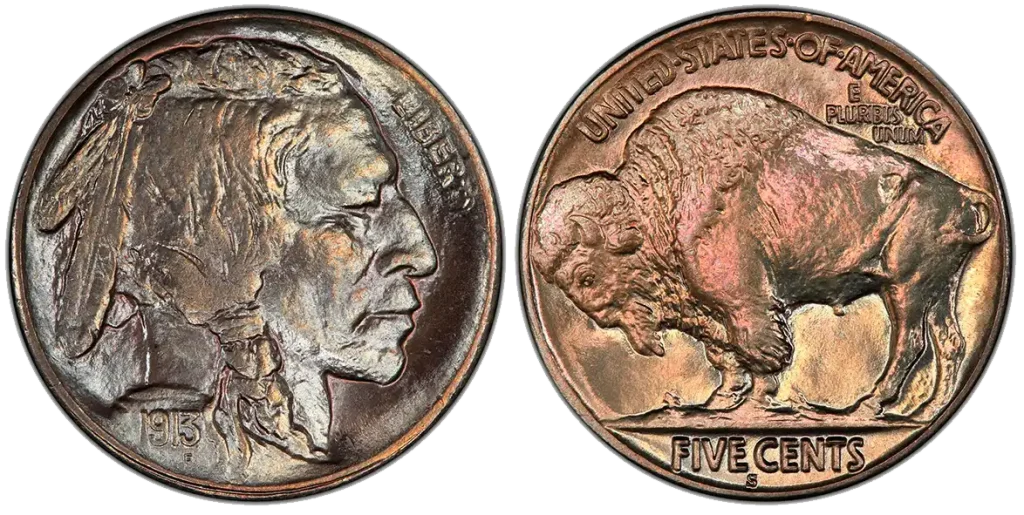
| Condition | Approximate Value |
| About Good (AG) | $800 |
| Good (G) | $1,000 |
| Very Good (VG) | $1,500 |
| Fine (F) | $3,000 |
| Very Fine (VF) | $7,000 |
| Extremely Fine (XF) | $9,000 |
| About Uncirculated (AU) | $12,000 |
| Uncirculated (UNC) | $15,000+ |
| Choice Uncirculated (CU) | $25,000+ |
The 1934 Indian Head nickel value is approximate and may vary depending on the condition, market demand, and other factors.
The year 1913 was important for American coins. This one is special because it was made in San Francisco (the “S” mark). Not many were made in 1913, which makes it rare today.
1926-S Buffalo Nickel
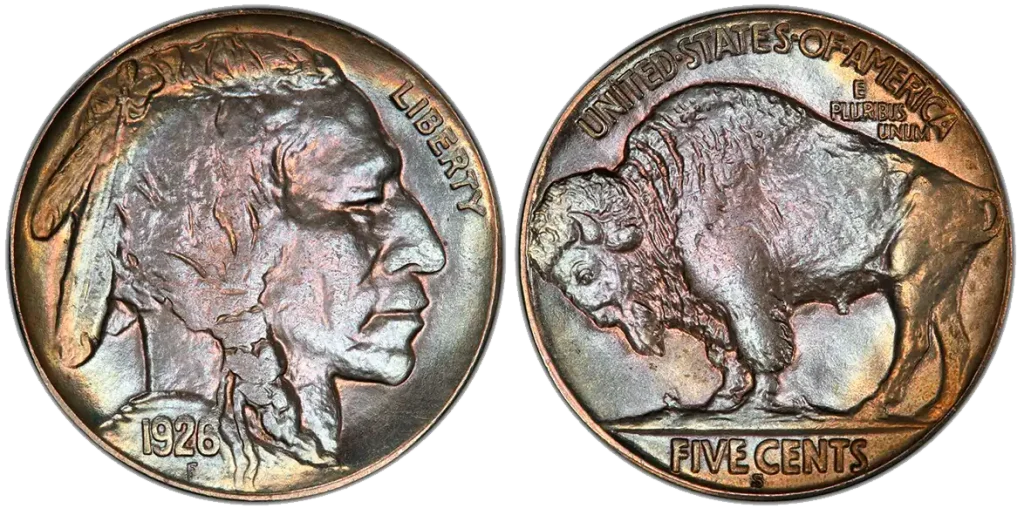
| Condition | Approximate Value |
| About Good (AG) | $400 |
| Good (G) | $500 |
| Very Good (VG) | $1,000 |
| Fine (F) | $2,000 |
| Very Fine (VF) | $8,000 |
| Extremely Fine (XF) | $12,000 |
| About Uncirculated (AU) | $18,000 |
| Uncirculated (UNC) | $20,000+ |
| Choice Uncirculated (CU) | $30,000+ |
The value of 1937 Indian Head nickel is approximate and may vary depending on the coin’s condition, market demand, and other factors.
In 1926, the San Francisco Mint made very few of these coins. This low number means that fewer coins are available for collectors now. The 1926 Indian Head nickel value is known to be higher for certain mints.
1937-D 3-Legged Buffalo Nickel
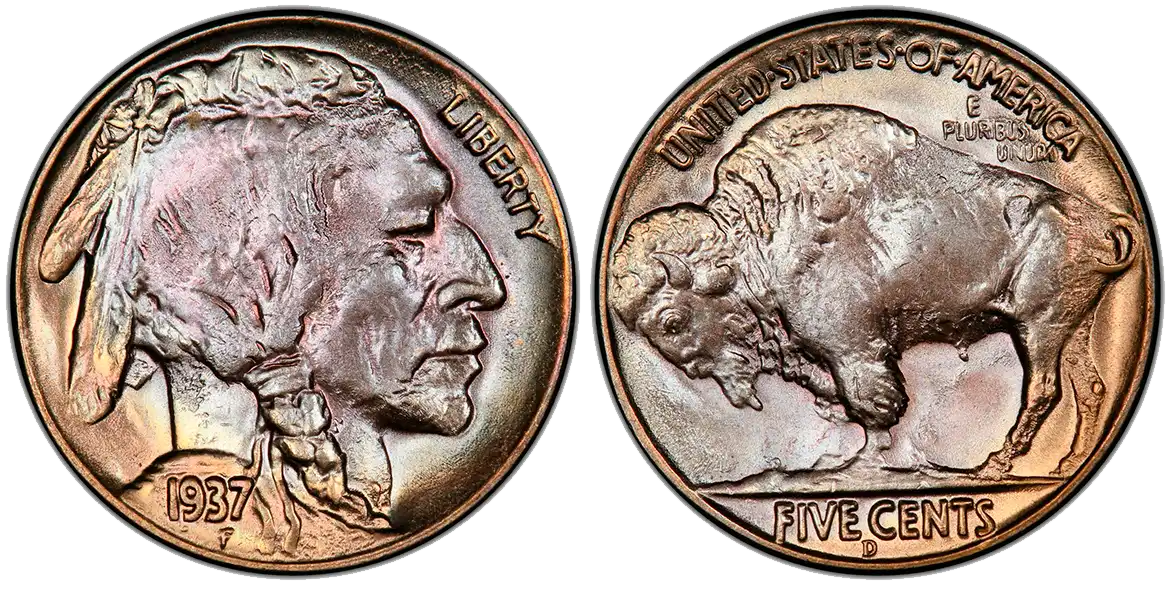
| Condition | Approximate Value |
| About Good (AG) | $1,200 |
| Good (G) | $1,500 |
| Very Good (VG) | $2,500 |
| Fine (F) | $5,000 |
| Very Fine (VF) | $15,000 |
| Extremely Fine (XF) | $25,000 |
| About Uncirculated (AU) | $40,000 |
| Uncirculated (UNC) | $50,000+ |
| Choice Uncirculated (CU) | $75,000+ |
The Indian Head dateless Buffalo Buffalo nickel value no date is approximate and may vary depending on the condition, market demand, and other factors.
This coin is famous because of a mistake. In 1937, at the Denver Mint (the “D” mark), a machine error happened. Part of the Buffalo’s leg was removed during the minting process. This unique error makes the token very special and highly wanted by collectors. You can learn the 1937 Indian Head nickel value by looking at a price guide.
Condition Rarities
- Full Date (No Wear) – Adds 50–200% premium
The value of Indian Head nickel coins depends on their date, mint mark, and condition. If you can see every number clearly and sharply, with no part rubbed away, that’s a “full date with no wear.” A clear date means the coin was not used much. It looks almost new. It can be worth one and a half to three times more money.
- Full Horn Detail – Essential for top grades
On a Buffalo Nickel, there’s a picture of a Buffalo with a horn. “Full horn detail” means you can see the whole horn, all its lines and shape are clearly. If the horn is complete and sharp, it shows the coin is in great shape. Coin experts look for this to decide if a coin is one of the best.
- Mint State (MS-65+) – Worth 10–100x more than worn examples
“Mint State” means the coin was never used as money. It looks like it just left the coin factory. It means the piece is almost perfect, very shiny, and has almost no marks. They are much, much more valuable than coins that look old and worn. For instance, the 1927 Indian Head nickel value can increase significantly for uncirculated examples.
How to Identify a Valuable Buffalo Nickel
Check the Date and Mint Mark
First, look at the year the coin was made. This is usually on the front. Then, turn the coin over to the back side. Below the words “FIVE CENTS,” you can see a small letter. This letter is called the mint mark. It tells you where the coin was made.
- If you see a D, it was made in Denver.
- If you see an S, it was made in San Francisco.
- If there is no letter, it was made in Philadelphia.
Examine the Horn and Date
- Full Horn: On the back of the coin, there is a picture of a Buffalo. Look at its horn. If the horn is sharp and clear with all its details, this is called a “full horn.” Coins with a full horn are often more valuable because it means the coin has less wear. For instance, the 1923 Indian Head nickel value is often higher for coins that show strong details.
- Weak Date: Sometimes the year on the coin can look blurry or hard to read. This is called a “weak date.” It happened often because of how these coins were made. A weak date usually means the coin is worth less money. A 1925 Indian Head nickel value is determined by its condition and strong date
Look for Errors
- 1937-D 3-Legged: One famous error is the 1937-D coin. On these coins, the Buffalo looks like it is missing one of its front legs. This happened by accident during the making of the coin.The value of 1936 Indian Head nickel coins can be found in detailed online coin catalogs.
- 1916/1916 Doubled Die: Another special error is the 1916 coin where some of the numbers in the date look blurry or doubled.
- Off-metal strikes: Very rarely, a Buffalo Nickel could be made on the wrong type of metal. For example, it could be made on a penny’s copper planchet instead of the usual nickel. These errors are very rare and highly sought after.
FAQ
How can I tell if my Buffalo nickel is silver?
Buffalo nickels are not made of silver. They are made from a mix of copper and nickel. This mix gives them their distinct light gray color. Silver coins usually have a brighter, whiter look.
Should I clean my old Buffalo nickel?
No, you should not clean your old Buffalo nickel. Cleaning a coin can damage its surface. This damage usually lowers its value. Collectors prefer coins in their original condition, even if they look dirty or old.
Why do some Buffalo nickels have no date?
Some Buffalo nickels appear to have no date because the date was on a raised part of the coin. This part was often the first to wear away from being used in daily trade. Over time the date rubbed off.
How much is a 1936 Buffalo nickel worth?
Finding the 1936 Indian Head Buffalo nickel value requires checking current market prices. A worn 1936 Buffalo nickel may be worth around $1 to $5. A coin in very good condition can be worth more, perhaps $10 to $30 or more if it is uncirculated.
What do the letters “D” or “S” on a coin mean?
The letters “D” or “S” on a coin are called mint marks. They tell you where the coin was made. “D” means the coin was made in Denver, Colorado. “S” means it was made in San Francisco, California. If there is no letter, the coin was made in Philadelphia. The 1930 Indian Head nickel value is usually modest unless the coin is in top condition or it is with rare mint mark.
What is the difference between Type 1 and Type 2 Buffalo nickels?
The Type 1 Buffalo nickel had the Buffalo standing on a mound or small hill. This design made the date wear away quickly. The Type 2 design changed the mound to a flat line. This change was made to help the date last longer on the coin.
How can I learn more about my coins?
You can learn more by looking at coin books or trusted services (PCGS or Coin identifier app). Coin collecting clubs are also a good place to ask questions and meet other collectors. You can also visit a professional coin seller who will help you identify and value your coins. Moreover, you can estimate the 1924 Indian Head nickel value by comparing it to similar coins online.
Key Takeaways
- Most Buffalo nickels are worth $1–$50. These common coins usually show some wear.
- Key dates (1913-S, 1926-S, 1937-D 3-Legged) are worth much more. Their value can range from $500 to over $50,000, depending on their condition.
- A full horn and a sharp, clear date significantly increase a coin’s value. Such details show the coin has very little wear.
- Never clean coins. Cleaning them will damage their original surface and ruin their value for collectors.
In conclusion, understanding the value of Indian Head Buffalo nickel coins requires knowing their history. From rare mint errors like the 1937-D 3-Legged variety to low mintage figures of early issues like the 1913-S Type 2, each coin has a story that directly impacts its worth. By learning about these historical details and the specific features you can better appreciate the coinage market.